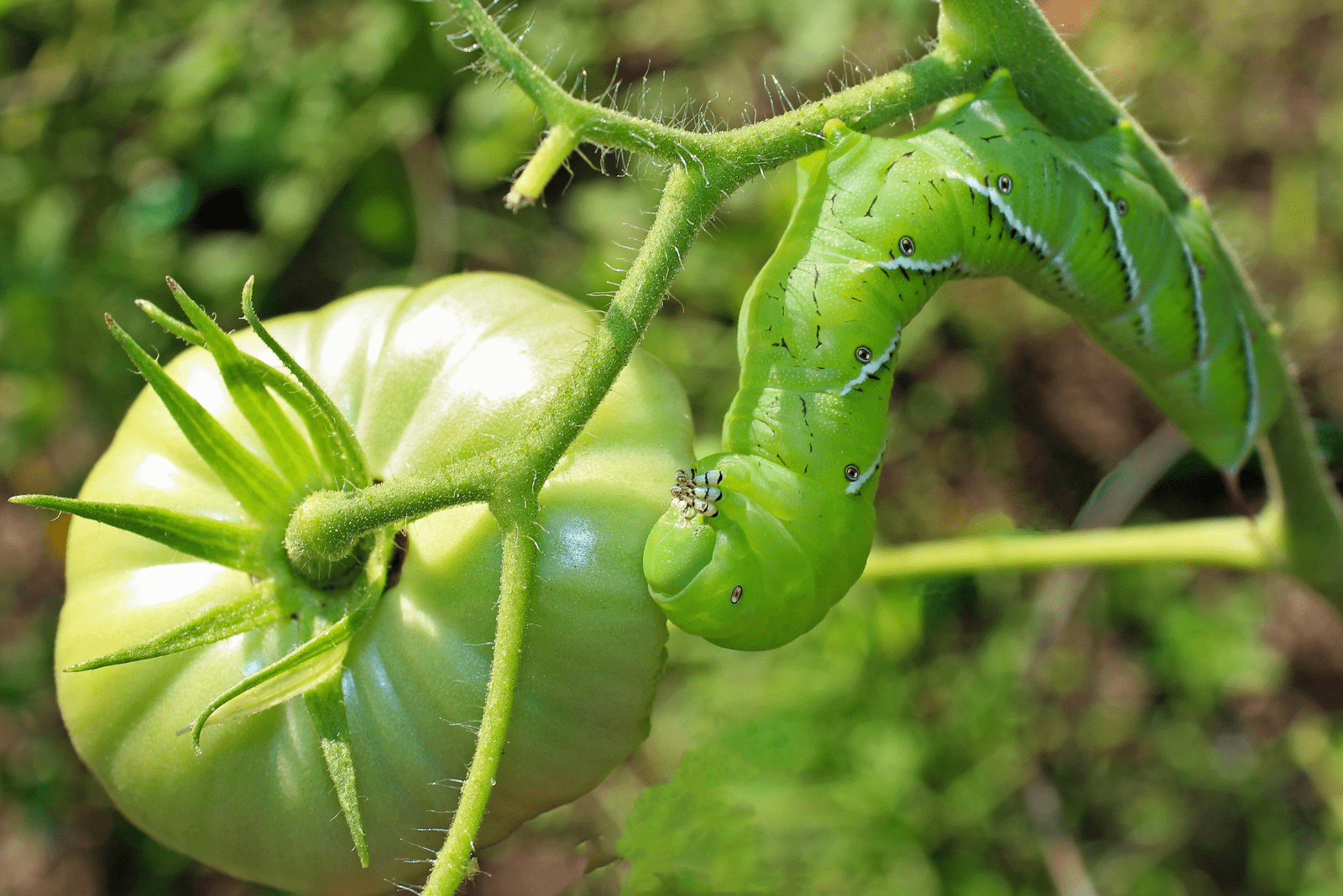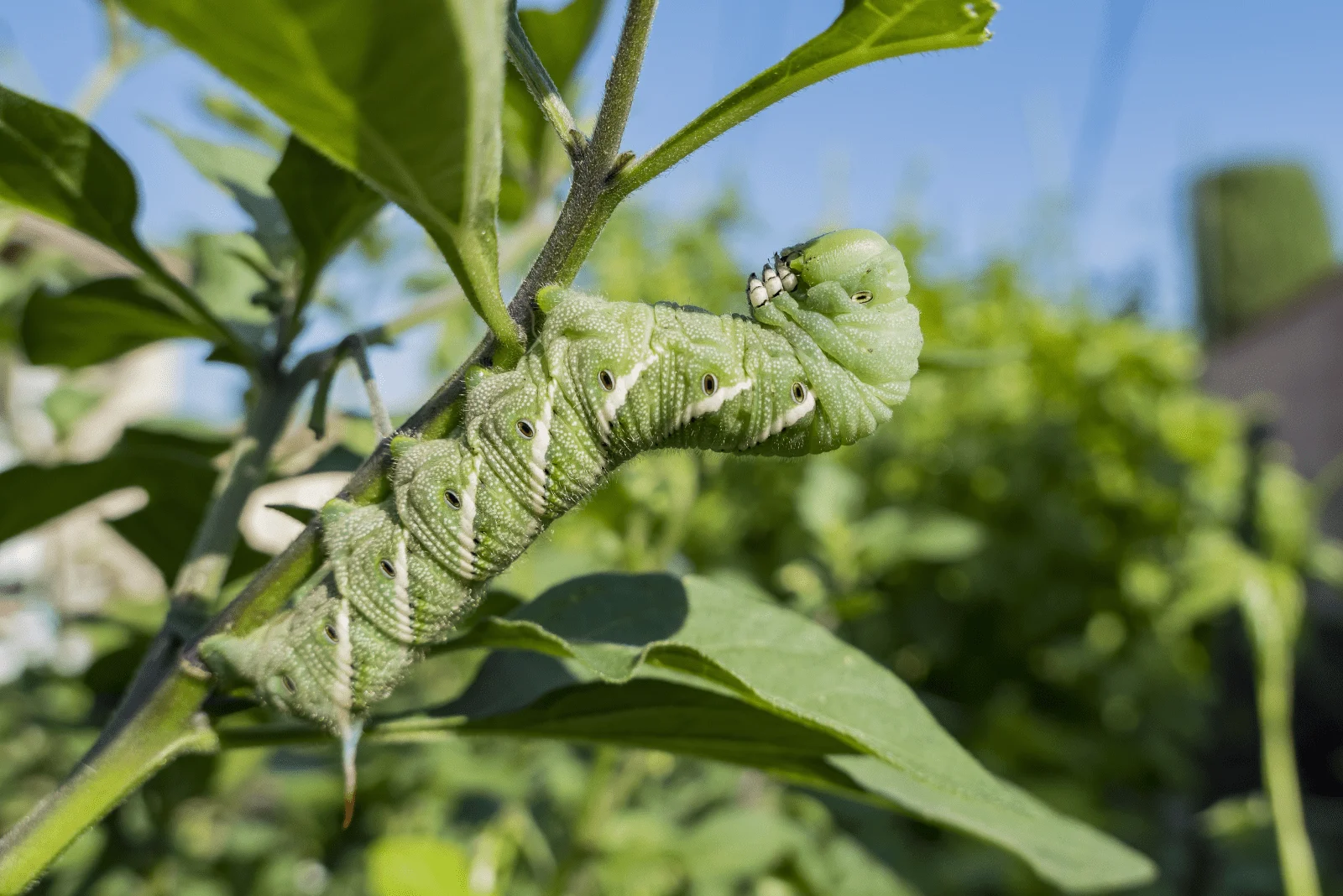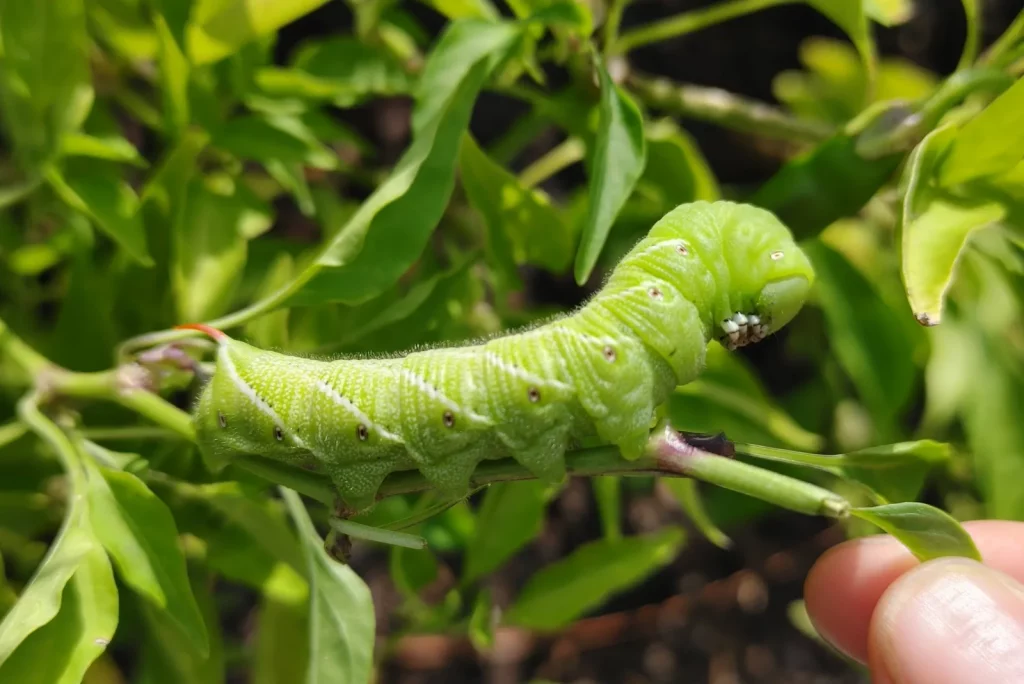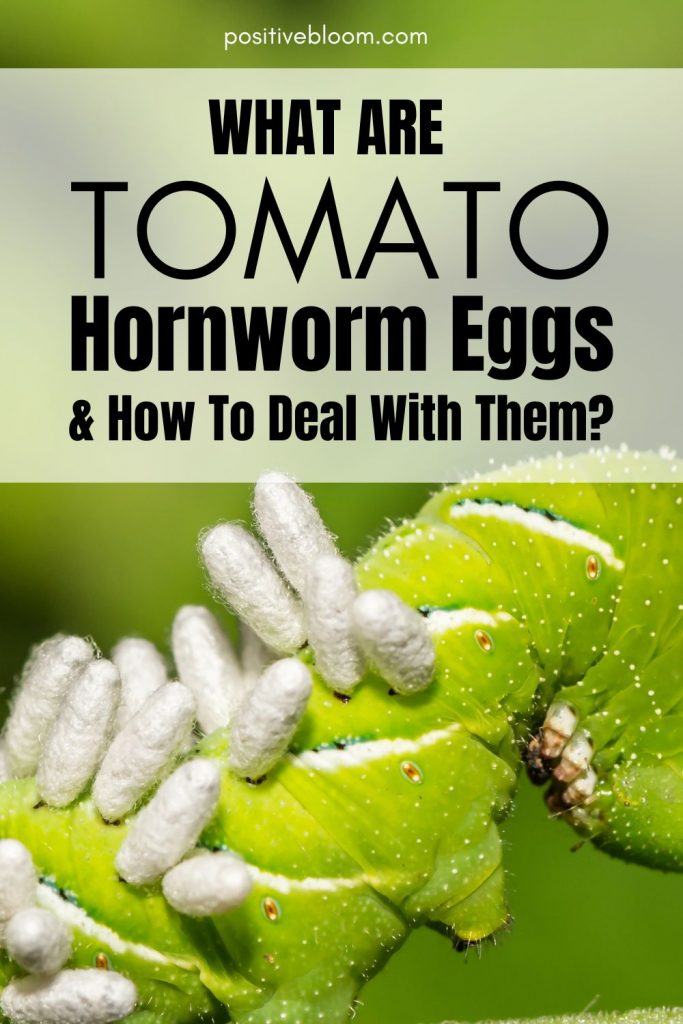Growing tomatoes in your summer greenhouse or garden is always an excellent idea, especially in an age where organic food is both hard to come by and rather expensive.
However, cultivating this vegetable isn’t always easy because you’ll sometimes have to deal with certain pest infestations or diseases.
Today, we’ll talk about the former and the most vicious insects you may notice on these nightshades: tomato hornworm eggs and caterpillars.
But what are these things, and how can you get rid of them?
We’ll answer these (and even more) questions in the sections below, so keep reading!
What Are Tomato Hornworm Eggs?
So, you’ve finally realized how to differentiate Black Krim from Cherokee Purple tomatoes, planted your choice, and then, all of a sudden, some green caterpillars appeared?
Are they dangerous? And what are they?
Unfortunately, yes! These insects are known as tomato hornworm caterpillars and can quickly colonize your tomato plants if you’re not careful!
But these larvae (caterpillars) just eat the tomatoes and cannot lay eggs. Of course, they do the most damage during this larval phase.
These pests usually attack tomatoes, but they love many different members of the Nightshade family, including eggplants, tomatoes, peppers, etc.
Furthermore, tomato hornworm eggs are just one stage in the lifecycle of this pest, and we’ll talk more about it in the following paragraphs.
What Is The Lifecycle Of A Tomato Hornworm?
In the gardening world and entomology, the tomato hornworm (or tomato worm) is known as Manduca quinquemaculata, and its average tomato hornworm lifecycle isn’t that long.
Therefore, it’s not surprising that one year can bring about two generations of these nuisances.
We’ll discuss these stages more thoroughly in the following sections so that you know what to expect of these bugs if they ever appear on your nightshades.
Eggs Hatch
Adult moths mate, after which the female moth lays light green eggs on the undersides of tomato leaves (or some other plant from the Nightshade family).
It takes about 6-8 days for the eggs to hatch and for small, yellowish caterpillars to appear.
As they grow, they turn a darker green and obtain eight white stripes, shaped like the letter V, on each side.
They are usually around 5 inches long and even have a so-called horn on their last segment, hence the name.
Larvae feed on the plant leaves and are detrimental to your plants. They first start feeding on the upper foliage and work their way down to the ground.
As they eat your plant’s foliage, these tomato caterpillars leave black or dark green droppings, which can help you confirm that you have a hornworm problem.
Mature Caterpillars Transform Into Pupae
After about 3-4 weeks, the larvae enter their last stage, drop off your plants, burrow into the ground, and pupate (turn into pupae).
During their last growth stage, hornworm caterpillars can eat almost the same amount as all the previous stages combined!
Grown Tomato Hornworm Moths Appear
Tomato hornworm moths are also known as sphinx or hummingbird moths, and they appear after about two weeks.
Of course, not all moths are hornworm moths, and you can recognize these ones by examining their wings. This moth has a wingspan of about 5 inches and narrower front wings spotted in brown shades. The back wings, on the other hand, have alternating dark and white parts.
Adult moths have yellow spots on the sides of their abdomens.
Female hornworms usually lay eggs on the undersides of plant foliage, but sometimes the eggs can appear on the upper sides.
The eggs are laid in as little as three days after moths appear, so you won’t get a moment of peace from these pests.
However, hornworm moths are considered pollinators, so they’re not complete parasites!
The Lifecycle Repeats
Don’t think that it all ends here! The lifecycle of tomato hornworms repeats, and the caterpillars keep colonizing your plants late into summer or even early fall.
But there’s more! Tomato hornworms can overwinter as pupae and appear as grown tomato hornworm moths in spring, so last year’s generation can end up destroying next year’s crops.
Elimination Of These Green Caterpillars
The good news is that tomato hornworms can be destroyed during their most destructive stage, so a master gardener can easily save their tomato plants.
Below, you can read some common ways of eliminating tomato hornworms, so don’t skip this part!
Picking Them Off By Hand
Handpicking caterpillars is not for everyone, but it can be a great control method if you have a small vegetable garden, plenty of patience, or if the infestation is not too large.
And the good news is that they don’t bite!
Once you remove these leaf-eating pests from your plants, you can give them to your chickens, drop them into a glass of soapy water, or crush them if that’s not too much for you.
Using Insecticidal Soaps
Insecticidal soaps are another excellent way to destroy tomato hornworms.
However, you have to ensure that this pest comes into direct contact with the substance for it to have any effect.
You’ll also have to reapply the insecticidal soap after it rains or once a long time has passed as it doesn’t remain active for long.
Finally, one of the things that makes it suitable for everyone, including growers who have a pollinator garden, is the fact that it has little-to-no effect on beneficial insects.
Using Pesticides
Finally, if the hornworm infestation is too large for you to handle, you can always turn to insecticides. For instance, using neem oil on tomatoes is relatively safe if you don’t use too much, and it is one of the natural pesticides that won’t clash with organic gardening.
There are many other organic insecticides, such as Bacillus thuringiensis, that will destroy the larvae without harming your plants or larger animals.
Prevention Of Tomato Hornworms
Even though it is possible to get rid of tomato hornworms, it’s better to prevent them from appearing on your plants in the first place.
The good news is that it is possible, but you’ll have to be patient.
Attracting Beneficial Insects (Wasps)
Attracting natural predators of tomato hornworms, such as paper and braconid wasps, lady beetles, and green lacewings, is an excellent form of biological control that will quickly solve your hornworm problems.
Of course, if you have plants such as dill, chamomile, sweet alyssum, etc., which attract wasps, you won’t ever have to deal with hornworms.
These tiny wasps (braconid wasps) are known as Cotesia congregatus, and they lay their eggs on the backs of hornworm caterpillars.
Their cocoons protrude from the hornworm’s body, while the larvae feed on the caterpillar. Soon, the wasp larvae transform into adult wasps, eliminating the hornworm before setting off to look for more!
Lady beetles and green lacewings feed on hornworm eggs and young larvae, so they can help you with your issue before you even notice anything wrong!
Tilling The Soil
Hornworms can survive winter as pupae in the soil, so you should till it before planting anything. There are excellent tillers for breaking new ground that can help you in this situation.
It’s believed that tilling can reduce the population of hornworm pupae in the ground by 90%, so why not give it a go?
Companion Planting
Another thing that can help you fight hornworms before they appear in your garden is companion planting.
The good news is that many herbs are excellent growing buddies to tomatoes precisely because of their ability to repel tomato hornworms.
Just research the companion planting chart for herbs and grow borage, lovage, dill, thyme, etc.
Can You Fix Hornworm Damage On Tomato Plants?
Unfortunately, you cannot erase the consequences of hornworms, but your plant can recover.
Cut off the eaten parts and any stems whose leaves have been eaten; tomato plants grow rapidly, and they will produce new shoots in no time.
Furthermore, inspect the entire plant and remove any caterpillars and eggs you find to keep new side shoots safe.
FAQ
Even though we have discussed many important things about tomato hornworm eggs, including what they are, the lifecycle of this pest, and some ways of eliminating and preventing them, there are still some other things that might interest you.
We will now answer the questions you asked us most frequently about this nuisance.
How many eggs do hornworms lay?
Female tomato hornworm moths can lay between 250-350 eggs, but that number will skyrocket to 1400 if the growing conditions are perfect.
This many caterpillars can destroy your plants, so remember to check the leaf undersides for light green eggs.
Is tomato hornworm the same as tobacco hornworm?
No, tomato and tobacco hornworm aren’t the same bug. The botanical name of the tomato hornworm is Manduca quinquemaculata, while the tobacco hornworm is referred to as Manduca sexta.
They both feed on plants from the Nightshade family, but you can tell them apart by examining caterpillars and moths.
Tomato hornworm caterpillars have eight V-shaped white lines and a horn on their last segment, while the tobacco hornworm larvae have seven stripes and an orange-red horn.
Tobacco hornworm moths have a wingspan of 4 inches, which is slightly shorter than the tomato hornworms’, which have a wingspan of about 5 inches.
Finally, the tobacco hornworm is mottled with shades of gray and brown, while tomato hornworm moths are usually spotted with brown hues and streaked with black lines.
Final Thoughts
This article included the most important facts about tomato hornworm eggs, such as what they are and what they turn into.
The eggs themselves aren’t threatening to your plants, but they quickly turn into larvae that can eat entire nightshade crops.
Therefore, we included some ways of getting rid of these pests before they can eat all your tomato plants.
Of course, it is always better to prevent certain issues before having to deal with them, so we also brought some useful tips for hindering tomato hornworms from infesting your veggies in the first place.
Hopefully, you won’t ever have to deal with these pests, but if you do, you’ll know how to react.
Good luck, and until next time!
Like this post? Share or pin it for later!





